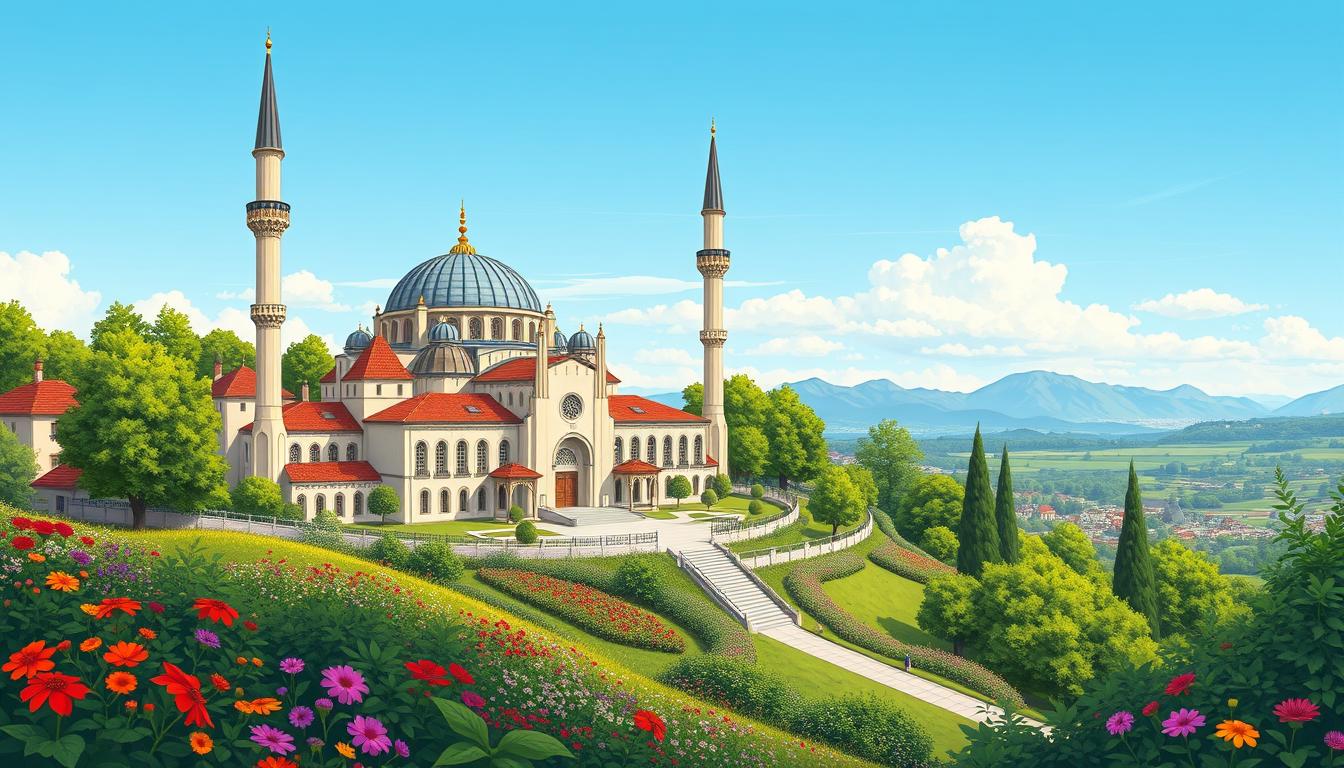Islam in Hungary
Surprisingly, Islam has had a presence in Hungary dating back to the 10th century. According to the 2011 Hungarian census, there were only 5,579 Muslims in the country, accounting for a mere 0.057% of the total population. Yet, despite their small numbers, the Muslim community in Hungary boasts a rich and fascinating history.
Of the Muslims recorded in the 2011 census, 4,097 (73.4%) identified as ethnically Hungarian, while 2,369 (42.5%) declared themselves as Arab. This diversity within the Hungarian Muslim population is a testament to the complex and multifaceted nature of the faith’s history in the region.
Key Takeaways
- Islam has had a presence in Hungary dating back to the 10th century, with a rich and complex history.
- The Muslim population in Hungary is small, accounting for only 0.057% of the total population according to the 2011 census.
- The Hungarian Muslim community is ethnically diverse, with 73.4% identifying as Hungarian and 42.5% as Arab.
- The influence of Sunni Islam was particularly pronounced in Hungary during the 16th century Ottoman period.
- The Hungarian Islamic Council was officially recognized in 2012, following a change in the law on religious organizations.
History of Islam in Hungary
The presence of Islam in Hungary can be traced back to the early medieval period. In the old form of the Hungarian language, Muslims were referred to as Böszörmény, a term derived from the Turkish Bozulmamış, which in turn descends from the Arabic Muslim. This term has been preserved as both a family name and the name of the town Hajdúböszörmény.
Early Islamic Influence
The first Islamic author to mention this Muslim community in Hungary was Yaqut al-Hamawi (575-626 AH/1179-1229 CE), who wrote about a famous Hungarian student who had studied in Aleppo. According to the student, there were 30 Muslim villages in Hungary at the time. The Spaniard Muslim traveler Abu Hamid al Garnati also wrote about two types of Muslims in Hungary: the Böszörmény of the Carpathian Basin and the Volga Bulgars (Khwarezmians).
Ottoman Rule in Hungary
The Turks entered Hungary after the Battle of Mohács in 1526. From 1541, they started to control the central part of the country directly and organized five eyalets: Budin, Kanije, Eğri, Varat (Oradea), and Temeşvar. During the 16th century, under Ottoman rule, several notable Muslim personalities were born in Hungary, including the Ottoman Grand Vizier Kanijeli Siyavuş Pasha, the Ottoman historian İbrahim Peçevi, and the famous Mevlevian dervish Pecsevi Árifi Ahmed Dede. Most Islamic studies in Hungary were taught according to the Hanafi madhhab, or Hanafi school of thought, of Sunni Islam.
“The Turks entered Hungary after the Battle of Mohács in 1526. From 1541, they started to control the central part directly and organized five eyalets: Budin, Kanije, Eğri, Varat (Oradea), and Temeşvar.”
Demographics of Muslims in Hungary
According to the 2011 Hungarian census, there were 5,579 Muslims in Hungary, making up only about 0.057% of the total population. Of these, 4,097 (73.4%) declared themselves as Hungarian, while 2,369 (42.5%) as Arab by ethnicity. The data from 2011 does not show the Turkish population.
The total population of Hungary is estimated at 9.7 million as of midyear 2022. While the Muslim community in Hungary is relatively small, the demographics have seen some changes in recent years. The number of Muslims in Hungary has increased from 3,000 to almost 8,000, showing a two and a half times rise over the past twenty years.
Other religious groups in Hungary include:
- Roman Catholic: 51%
- Hungarian Reformed Church (Calvinist): 16%
- Lutheran: 3%
- Greek Catholic: 2%
- Jewish: Less than 1%
- No religious affiliation: 23%
- Atheists: 2%
- Various other religious groups, including Buddhists and the Hungarian Society for Krishna Consciousness: Less than 5%
It’s worth noting that a new census was conducted in October and November 2022, with results not yet published. This census included an optional question on religious identity, which may provide further insights into the evolving religious demographics in Hungary.
“The number of Muslims in Hungary increased from 3,000 to almost 8,000, showing a two and a half times rise over the past twenty years.”
Islam in Hungary During the Modern Era
Hungarian Exiles in the Ottoman Empire
In the 19th century, after the collapse of the revolution of 1848-9, more than 6,000 emigrated Poles and Hungarians followed General Józef Bem (Murat Paşa) into Turkish exile. Among them were such Hungarian officers as Richard Guyon (Kurşid Paşa), György Kmety (Ismail Paşa) and Maximilian Stein (Ferhad Paşa). These personalities were afterwards raised to the post of General. Guyon is described in the Oxford Dictionary of National Biography as “the first Christian to obtain the rank of pasha and a Turkish military command without being obliged to change his religion”.
The Hungarian exiles in the Ottoman Empire played a significant role in the modernization of the Turkish military during this period. They brought with them European military tactics and strategies, which were quickly adopted and integrated into the Ottoman forces. This influx of Hungarian expertise helped to strengthen the Ottoman Empire’s position and influence in the region.
“Guyon is described in the Oxford Dictionary of National Biography as ‘the first Christian to obtain the rank of pasha and a Turkish military command without being obliged to change his religion’.”
The presence of these Hungarian exiles in the Ottoman Empire also facilitated cultural exchange and understanding between the two nations. The interaction between the Hungarian officers and their Ottoman counterparts helped to bridge the gap between the Christian and Islamic worlds, fostering a greater appreciation for each other’s cultures and traditions.
The legacy of the Hungarian exiles in the Ottoman Empire continues to be felt today, as the connections forged during this period have had a lasting impact on the relationship between Hungary and the Muslim-majority countries in the region.
Religious Laws and Recognition of Islam
Hungary’s approach to Islam has undergone significant changes over the years. In 2011, the country enacted a new “Law on the Right to Freedom of Conscience and Religion, and on Churches, Religions and Religious Communities,” which recognized only 14 religious groups. Islam was not included in this initial list, requiring Muslims to apply for official recognition under the new law.
However, in 2012, the Hungarian parliament amended the controversial law by expanding the list of officially recognized organizations to include the Hungarian Islamic Council. This move marked an important step in the legal recognition of Islam within the country.
The legal status of religions in Hungary has evolved over time, transitioning from the Catholic Church’s dominance as a state church to a system of equality among all religions. The Islam Law of 1912 in the former Habsburg Monarchy, for instance, imposed certain restrictions on Muslim practices, such as requiring civil marriage ceremonies for Muslims.
More recently, Hungarian laws have sought to protect the freedom of conscience and religion, as well as the rights of religious communities. Section 215 of the Criminal Code stipulates that individuals who restrict freedom of conscience or prevent the free exercise of religion through violence or threat can face up to three years of imprisonment.
Despite these legal developments, the recognition and acceptance of Islam in Hungary have faced some challenges. The Congress of Berlin and the annexation of Bosnia-Herzegovina contributed to the need for state-level regulation of Islam, which has had an impact on the community’s religious practices and freedom.
As Hungary continues to navigate the complexities of religious diversity, the legal recognition and protection of Islam remain important considerations for the country’s policymakers and religious leaders.
“The legal status of religions in Hungary underwent changes, moving from the status of a state church for the Catholic Church to the equality of all religions in Hungary.”
Islam in Hungary
While Christianity, particularly Roman Catholicism and Calvinism, remain the dominant religions in Hungary, the country has a long and complex history with Islam. The presence of Islam in Hungary dates back to the medieval period, when Turkic tribal groups like the Pechenegs and Kipchaks brought their Islamic faith to the region.
During the Ottoman rule in Hungary, which lasted from the 16th to the 18th century, the Islamic influence left a lasting impact on the country’s architecture and culture. The Ottomans built mosques, türbes (mausoleums), and public baths (hamams) that can still be seen in various parts of Hungary today. The introduction of Turkish cuisine, including the popularization of coffeehouses and the use of paprika, also became integral to the local culinary landscape.
In modern times, the Muslim population in Hungary accounts for around 0.3% of the total population. The majority of Muslims in Hungary are immigrants, hailing from diverse backgrounds such as Arab, Turkish, African, Afghan, and Iranian communities. They are primarily concentrated in the capital city of Budapest, with smaller communities in other urban areas like Debrecen, Pécs, and Szeged.
Despite the relatively small size of the Muslim community, there have been efforts to establish a more prominent Islamic presence in Hungary. In 2014, the council of Újbuda granted permission for the Muslim community to build the first Islamic center in Budapest, which will house a library containing 50,000 volumes.
The Muslim population in Hungary has faced some challenges, including instances of Islamophobia and verbal abuse, particularly when individuals display visible signs of their Muslim identity, such as wearing a hijab. However, the presence of Muslims in Hungary is not a significant political issue, and the community continues to navigate its place within the country’s diverse religious landscape.
Anti-Muslim Sentiments and Disinformation
Hungary’s history with the Muslim culture dates back to the Ottoman rule, which lasted over 150 years between 1541 and 1699. Despite this period of cohabitation, mosques and baths from the Ottoman era are now considered part of the nation’s cultural heritage, rather than sources of animosity.
Historic Roots
The lack of a large, visible Muslim community in Hungary has led to a lack of deep knowledge about Islam among the general public. This changed in 2015, when an unprecedented number of asylum-seekers passed through the country during the refugee crisis. However, the number of migrants in Hungary has fallen considerably since the tightening of asylum regulations and the construction of the Southern border fence in the fall of 2015.
Immigration and the Refugee Crisis
According to research, anti-immigration, anti-Arab, and anti-Muslim sentiments in Hungary have significantly increased post-2015, overshadowing traditional xenophobic attitudes towards groups like Gypsies and Jewish people. The ruling party, Fidesz, has been successful in shaping public discourse on migration since 2015, leveraging media control and propaganda campaigns that promote hate speech, conspiracy theories, and disinformation about Muslims in Hungary.
The populist right and far-right movements in Hungary share similar ideologies, focusing on nationalism, securitization of migration, anti-liberalism, and anti-establishment sentiments. This has led to a narrative that frames Islam within a cultural war context between the Christian West and the Muslim world, despite the fact that Muslim immigration in Hungary has been relatively low compared to other European countries.
“The far-right and populist right view Hungary as an ethnically homogeneous, Christian country with a shared language, culture, and values.”
Despite the negative rhetoric about Islam and Muslims in mainstream communication, Hungarian government officials have adopted a double standard, praising Muslims at diplomatic events while promoting disinformation about Muslims in Hungary to the domestic audience.
Political Campaigns Targeting Muslims
Hungary’s governing party Fidesz has spearheaded political campaigns that target Muslim communities in the country. Leveraging the traditional aversion towards “outsiders” prevalent in Central and Eastern Europe, Fidesz has successfully kept the issue of immigration at the forefront of the national agenda.
Through relentless state-sponsored disinformation campaigns, Fidesz has employed hate-inciting rhetoric, conspiracy theories, fake news, and half-truths to fuel public sentiment against Muslims. Narratives around the so-called “Soros-plan” and distorted facts about Muslim communities have been used to stoke fear and suspicion.
Despite the fact that only 5,000 out of Hungary’s 10 million population are Muslim, representing one Muslim per every 2,000 inhabitants, Fidesz’s anti-Muslim rhetoric has gained traction. In a recent Pew Research survey, 72% of Hungarians viewed Islam negatively, the highest proportion in Europe.
Fidesz’s political campaigns against Muslims in Hungary have exploited the country’s historical unease with foreign influences, capitalizing on the refugee crisis to further marginalize Muslim communities. This strategy has proven effective, as evidenced by Viktor Orbán’s consecutive electoral victories since 2010.
Public Opinion Towards Muslims
The public opinion on Muslims in Hungary has been a subject of ongoing debate. According to the Pew Research Center, in 2016, a staggering 72% of Hungarians had unfavorable views of Muslims, significantly higher than the European Union median of 43%. This sentiment was further exacerbated by the refugee crisis, with Hungarians being more likely to consider refugees a burden or a significant threat than the average European.
However, the landscape has shifted in recent years. The most recent data from Pew Research shows that the animosity towards Muslims has dropped from 72% to 58% between 2016 and 2019, as the topic became less prominent on the political agenda. This suggests that public opinion on Muslims in Hungary is gradually evolving, though anti-Muslim sentiments still remain a significant concern.
It’s worth noting that the negative attitudes towards Muslims in Hungary are not unique to the country. Neighboring nations like Slovakia (77%), Poland (66%), and the Czech Republic (64%) also exhibit high levels of unfavorable views of the Muslim community. This regional trend highlights the complex and sometimes divisive nature of the public opinion on Muslims in Hungary and the broader Central European context.
“In a 2018 poll, 45% of Hungarians agreed that Muslim leaders have a secret plan to conquer Europe, and 48% agreed that Muslims want to enforce their culture on Europe stealthily.”
Despite the gradual decline in anti-Muslim sentiments, the legacy of hate-incitement rhetoric and conspiracy theories continues to shape the public discourse in Hungary. As the government navigates its policies and diplomatic relations, the challenge of fostering a more inclusive and tolerant society remains a pressing issue for the country.
Government Policies and Contradictions
The Hungarian government’s immigration policy stands in stark contrast to its public rhetoric on Muslims and refugees. Despite the government’s harsh stance against Muslim immigration, the reality paints a different picture. In the last five years, Hungary has accelerated the issuance of residency permits to non-EU nationals, with a significant proportion going to guest workers from Muslim-majority countries, such as Iran.
Prime Minister Viktor Orbán’s treatment of Islam and Muslims during official diplomatic events also contradicts the government’s anti-Muslim narrative. For instance, during the 2015 visit of Egyptian President Abdel-Fattah El-Sisi, Orbán praised Islam for its “honorable, spiritual, and intellectual contributions,” and described Muslims as representatives of a “high civilization.” This pragmatic foreign policy approach has allowed Hungary to build close ties with predominantly Muslim, authoritarian countries.
Issuing Residency Permits
In 2020 alone, Hungary issued 55,297 residency permits, a substantial number for a country with a population of 10 million. While the government’s public stance suggests a harsh stance on Muslim immigration, the reality is that a considerable proportion of these permits have been granted to individuals from Muslim-majority countries.
Diplomatic Relations with Muslim-Majority Countries
Despite the government’s rhetoric, Hungary’s foreign policy has been “pragmatic” enough to foster close relationships with authoritarian, predominantly Muslim countries. This approach has allowed the government to balance its domestic anti-Muslim narrative with maintaining beneficial diplomatic and economic ties.
“The foreign policy of the Hungarian government is ‘pragmatic’ enough to build close ties to (partly religious, party secular) authoritarian countries with predominantly Muslim backgrounds.”
Recent Controversies Involving Muslims
Hungary has been the center of several controversies involving Muslims in recent years. One notable incident occurred when Prime Minister Viktor Orbán made controversial statements about Bosnia Herzegovina, stating that integrating the country into the European Union could be a challenge because “how we manage the security of a state in which 2 million Muslims live is a key issue for their security too,” alluding to the large Muslim population in the country. Bosniak leaders strongly condemned Orbán’s remarks and canceled a meeting with the Prime Minister in response.
Additionally, the Hungarian government has faced criticism for its failure to publicly condemn China’s policies against the Uyghur population in Xinjiang. Despite the international outcry over the persecution of Uyghur Muslims, Hungary has remained silent on the issue, drawing criticism from human rights groups and Muslim-majority countries.
“The increase in the Muslim population in Austria began in the 1960s and 1970s with the arrival of tens of thousands of guest workers from the Balkans and Turkey.”
These controversies involving Muslims in Hungary and Orbán’s statements on Bosnia Herzegovina have further fueled the ongoing debate surrounding the role of Islam in the country and the government’s approach to addressing the concerns of the Muslim community.
Conclusion
The story of Islam in Hungary is a complex and multifaceted one, with roots dating back to the 10th century. While the influence of Sunni Islam was particularly pronounced during the Ottoman period, the modern Muslim population in Hungary remains relatively small, comprising only around 0.057% of the total population.
Despite this, the issue of Islam and immigration has become a prominent part of the political discourse in Hungary, with the governing Fidesz party engaging in campaigns that have fueled anti-Muslim sentiments and conspiracy theories. However, a closer examination of the government’s policies and diplomatic relations suggests a more pragmatic approach than the rhetoric would suggest, with residency permits being issued to guest workers from Muslim-majority countries and close ties being maintained with some authoritarian states in the Muslim world.
The complexities and contradictions surrounding the role of Islam in Hungarian society highlight the need for a balanced and nuanced understanding of this multifaceted issue. As Hungary continues to grapple with the challenges of integration, it is essential that policymakers and the public approach the topic with empathy, open-mindedness, and a commitment to upholding the fundamental values of diversity and religious freedom.
Source Links
- Islam in Hungary
- Anti-Muslim populism in Hungary: From the margins to the mainstream
- Medieval Hungary and the Islamic World
- Islam in Austria-Hungary / 1.0 / encyclopedic – 1914-1918-Online (WW1) Encyclopedia
- Hungary – United States Department of State
- Number of Muslims in Hungary doubled in twenty years, while number of Catholics halved
- A Brief History Of Hungary’s Controversial ‘Islamic Churches’
- No title found
- The Islam Law of 1912: an example of the integrative effect of the multi-ethnic empire
- 009_HStud_33(2019)2-chap09_Varsanyi-print.indd
- Religion in Hungary
- Anti-Muslim populism in Hungary: From the margins to the mainstream
- Hungary – United States Department of State
- The Visegrad Group: the Czech Republic, Hungary, Poland and Slovakia
- Factsheet: Viktor Orban – Bridge Initiative
- 6. Minority groups
- A Closer Look at How Religious Restrictions Have Risen Around the World
- Contesting Flexible Solidarity: Secular and Religious Support for Refugees in Hungary
- National Profiles | World Religion
- Opinion | Austria’s Islamic Reforms (Published 2015)
- Discourses of being a Muslim woman in contemporary Hungary and the …
- Where the Wild Things Are: Fear of Islam and the Anti-Refugee Rhetoric in Hungary and in Poland







